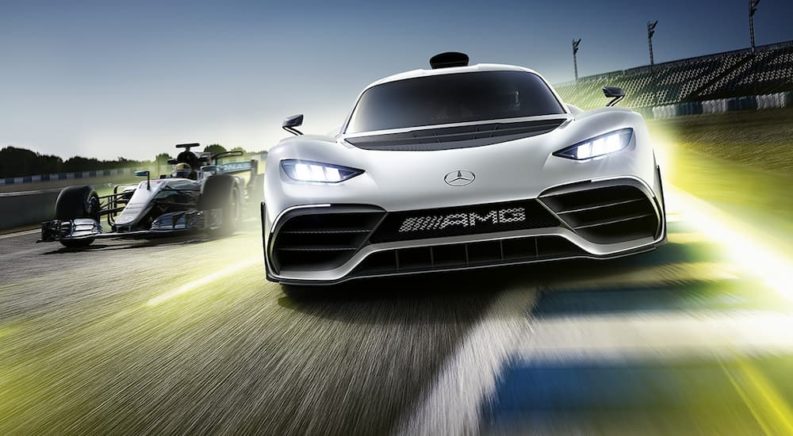“The Green Hell,” as Sir Jackie Stewart named it, may be the most demanding track on Earth. There are those which are older, more renowned, or drive faster, but no permanent circuit is longer nor features more varied topography. The Nurburgring is one of the most dangerous tracks in the world, so long and winding that even the weather can change in the course of a lap. It’s only natural, then, that sports car credibility almost requires development time on the Nordschleife, and no surprise that placing high on its legendary lap time leaderboard is an instant ticket to stardom. Nothing says “ultimate sports car” quite like “fastest on the Nurburgring,” and as of Halloween 2022, there’s a new king of the ‘Ring in the Mercedes-AMG ONE.
The ONE lives life in fast forward, even while featuring less than two liters of displacement. It’s been a long pandemic-delayed road to production for the instantly iconic hypercar, but now it’s here, and all 275 examples will roll off the line by the end of 2023. Of course, they were all sold before we even knew the specs, but now the owners must feel even more confident they’ll never lose a penny of their nearly $3 million investments. The ONE is, after all, the fastest production car to ever circumnavigate the Nurburgring––the second Mercedes to accomplish the feat in the last three years.
A Looooong Time Coming
2014 was a big year for Mercedes racing. How big? Well…big enough to require a little history lesson.
Once upon a time, a guy by the name of Juan Manuel Fangio––ever heard of him?––raced a Mercedes to consecutive Formula One championships. The second of those was in 1955––the same year as the infamous Le Mans catastrophe that led Mercedes to completely withdraw from motorsports. After a long absence, Mercedes power plants eventually returned to racing and reached the winner’s circle in a Hakkinen-guided McLaren in 1998, then again in Button’s Brawn a decade later. Finally, 55 years after the disaster that led them to quit racing, the Mercedes Formula One team returned in 2010.
Their rise to the top was swift, and just one year after signing Sir Lewis Hamilton in 2013, Mercedes knocked Red Bull and four-time-defending-champion Sebastian Vettel off the top spot. Once they got back to the top, their grip on the sport tightened like a carbon fiber vise. Mercedes would not lose the constructor’s championship again until 2022! In the midst of this unprecedented run of dominance––only Ferrari and Schumacher’s six-peat in the 2000s comes close to Mercedes’ eight straight championships––one could understand if they thought the time was right to build a road-going variant of their world-beating Formula One car.
Project One was announced in 2017 for a 2019 release but suffered development delays that pushed it back into the pandemic era. This (and the ensuing supply crises) inevitably delayed the Mercedes-AMG ONE even further to late 2022. Mercedes’ outright dominance in Formula One may be at an end as they approach the end of the 2022 season trailing both Red Bull and Ferrari. However, they’ll continue to make headlines for at least a little while longer with the ONE shattering records and blowing minds around the world.
No ONE Like It
Perhaps it shouldn’t be surprising that the Formula One-derived hypercar bears a striking resemblance to the legendary Mercedes-Benz CLK GTR Straßenversion. Once the most expensive production car in the world, the CLK GTR was a homologation special built by reverse engineering a McLaren F1 GTR, featuring the same low, broad nose, similar side scoops, a huge (but not tall) rear wing, and of course, an iconic roof scoop. Both the CLK GTR and ONE also feature wheels with a bajillion spokes (23 on the CLK GTR, 10 for the ONE––I guess our attention spans are shorter in 2022) and look completely unlike anything else in the Mercedes lineup. At least the CLK GTR tried to keep the grille and headlamps familiar; the ONE nearly looks like a Koenigsegg.
But what if it does? The point is to be aerodynamically efficient and effective––generating downforce, minimizing drag, and feeding the engine and the radiators. Far more intense than the aero, however, is the powertrain, generating over 1000 hp and revving to 11,000 RPM before topping out at nearly 220 mph. Like a modern reincarnation of the Ferrari F50, everything that can be Formula One is Formula One, including this radical powertrain. Mercedes’ hybrid hypercar features a turbocharged 1.6L V6, which is good for 566 hp on its own and is then supplemented by four electric motors in highly diverse locations.
Two 161 hp motors power the front wheels independently, allowing for infinitely-adjustable torque vectoring at the front end. Another such motor attached directly to the crankcase boosts the engine’s output to send 727 hp to the rear wheels (the 322 hp at the front then brings us to a neat 1,049 hp total) under maximum output conditions.
But that’s only three motors! Where’s the fourth? The sneaky little 120-hp devil is mounted on the turbocharger, spooling it up at 100,000 RPM to eliminate the woes of turbo lag. The result is an acceleration of seven seconds…to 120 mph. The ONE reaches 60 mph in 2.9 seconds and 180 mph in 15.6 seconds; even at over 3700 lbs, this thing is quick! Of course, you knew that already. But because the ONE depends on electric power, even with up to 80% of the car’s kinetic energy recoupable through regenerative braking, making the most of that power requires careful management––which is what you’d have to do to steal the production car lap record on the Nurburgring.
The Kings of the ‘Ring
Complete with a yoke steering device bedazzled with important controls like the Drag Reduction System (which trades downforce for acceleration on demand), the ONE is more Formula One racer than road car. But a production car it is, and the record holder it remains (until Porsche comes up with something else to beat it––a new 911 GT1, maybe?). Its manic time of 6:35.18 around the Nordschleife made the proof video look like it’s playing in fast forward and beat the old record by a sound 8.12 seconds––the largest margin since 2005, six usurpations ago!
It takes real chops to steal the Nurburgring crown, even if only for a moment, and Mercedes may only have enough time to finish ONE’s production run before somebody else rips it away. That’s because, in the last 33 years, no fewer than 16 production cars have held the title of “fastest ’round the ‘Ring”––but some records have stood longer than others, and Mercedes just might have one of them.
In the early 1990s, the record was held primarily by Japanese makers. The Nissan Skyline was the fastest in 1989, with the Honda NSX and then NSX-R nabbing it in 1990 and 1992, but none ever broke the 8:00 minute mark or held their title for more than a year (a 911 Turbo 3.3 held the record in 1991). This score was settled by none other than the Bugatti EB110, whose 1993 time of 7:44 decimated the Honda’s 8:03 and would stand as the record for nine years.
This remarkably stout achievement was only matched, not beaten, by the Pagani Zonda S 7.3 in 2002, and it’d be a whole extra year––a full decade since the 7:44 mark was set––before the Porsche Carrera GT brought the record back to Stuttgart with a 7:32.4. This 11.6-second hike was one of the largest in Nurburgring history, and considering that it was another Carrera GT that broke the 7:30 mark in 2004 one might say it was actually a 16-second leap from the EB110.
Either way, Porsche’s record was stolen by the Dutch Donkervoort D8 RS barely a year later. This kazoo-looking plaything was built for one thing only and did it well, raising the bar to 7:18. The Netherlands nearly managed a whole year on the throne before a British company named Radical took a long, hard, screwbally look at the rules, and exploited them like they were colonies, presenting the SR8 and then the SR8 LM––the first production cars to crack the incredible seven-minute mark.
These notorious “production” cars received a “Single Vehicle Approval” in Britain to be road-legal and not a full-type approval, making their status questionable and causing some to leave them off the list of record holders. I mean, come on, have you ever seen one? They’re like a go-kart for Le Mans! Because nobody else was so brazen as to not even disguise their race car as a road car, Radical was able to hold the record from 2005 to 2017. Beating Donkervoort by a whopping 30 seconds probably had something to do with that––Radical was just in an entirely different league that actual production cars couldn’t catch up to for more than a decade.
A New Era on the Nordschleife
Once they did catch up, though, they came in force. The record has changed five times in five years now, and three of those record-setting runs belong to Stuttgart, which seems determined to not relinquish the fictional trophy again.
When a Porsche 911 GT2 RS finally beat Radical with a 6:47 nearly 12 years to the day that the SR8 broke the seven-minute mark, its 1.03 second lead over the SR8 LM was the slimmest margin in the record’s modern history. No surprise, then, that less than a year later, the record was stolen away by a Lamborghini Aventador, an LP770-4 SVJ to be exact, with a 6:44.97 that was good enough to hold up for nearly three years.
Next was Mercedes, who wrestled the win back for Germany with an AMG GT Black Series that clocked a 6:48.047 with Maro Engel at the wheel. This was the first record from the lengthened official circuit, which adds about a five-second penalty and thus yielded the record to this “slower” time by nearly two seconds. But Porsche hadn’t been sleeping––months later, another 911 GT2 RS, this time with the factory Manthey Performance Kit equipped, set a 4.74 s margin on the Merc and broke through 6:44 for realsies even with the longer circuit.
That record would have stood to this day if not for the ONE (which, to be fair, was supposed to come out three years ago and prevent this Game of Thrones-esque nonsense). The 6:35.183 is eight seconds faster than Porsche was just last year. It’s a tremendous feat, but if history is any indicator, to really lock down this crown, one needs to clear the old mark by 15+ seconds. We’re due for another performance plateau soon, but I suspect we won’t reach it until somebody clocks a 6:30 around 2025. So enjoy it while you can, Mercedes fans and proud ONE owners––it might end up as a spot of lucky timing to drive yours while it’s still the one and only king of the ‘Ring.
Perfectly Flawed
Nothing went right for the Mercedes-AMG ONE during its development. Its release was delayed for years. It gave Top Gear trouble during testing with inconsistent powertrain operation (even when it’s working right, a full engine rebuild is required as standard maintenance every 50,000 miles). And when it came time to set its mark on the Nordschleife leaderboard, it couldn’t get a win, with far from optimal weather conditions leaving parts of the track wet and extra dangerous for driver Maro Engel.
Yet the ONE still pulled it out. Three years late, with radical technology and terrible conditions, it still set the fastest time by one of the largest margins in modern Nurburgring history. May that victory in the face of adversity stand as a testament to the Formula One legacy that inspired it. At least, that’s until Porsche loses its mind and makes a “production” version of its new 963 LeMans prototype.




